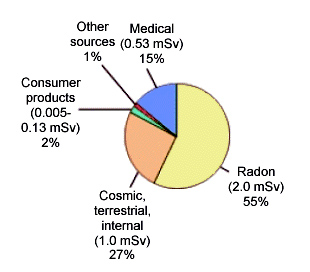Estimating Doses to Servicemen Stationed Near Hiroshima
by Shoichiro Fujita, Department of Statistics
This article was originally published in RERF Update 6(2):11, 1994.
Figure. During their 2-year stays in the Hiroshima area beginning a few months after the atomic bombing, Australian servicemen received estimated radiation doses ranging from 0.05-0.2 mGy to 1.2 mGy. The figure below shows, for comparison, the annual doses received per capita in the US from naturally occurred and manmade sources of radioactivity, often referred to as “background” radiation. The total yearly dose is approximately 3.6 mSv (3.6 mGy), ie, 1.6 to 40 times greater than the doses received by the servicemen in 2 years. Thus, for a 70-year-old man, the risk of developing cancer from naturally occurring background radiation is about 700 times greater than from the dose received in Hiroshima.

Courtesy of the NCRP
(NCRP Report No. 93, pp 53-55, 1987)
In recent months, RERF’s chief of research has responded to various inquiries from former Australian servicemen who, during the post-World War II occupation of Japan, had spent time in Hiroshima.
Although doses to the atomic-bomb (A-bomb) survivors are attributed mostly to the direct radiations produced by the weapons, residual radioactivity was produced by neutron activation of soil near the hypocenter and by radioactive fallout of activation and fission products from the clouds formed by the explosions. The Dosimetry System 1986, used to estimate doses, is derived from the direct, instantaneous A-bomb radiation and does not include individual dose estimates from the aforementioned residual radiation components.
The upper limits of possible doses from induced radioactivity and fallout have been presented in the US Japan Joint Reassessment of Atomic Bomb Radiation Dosimetry in Hiroshima and Nagasaki. Final Report (Vol 1, 1987, Hiroshima, RERF, pp 205-226).
The estimated maximum absorbed doses from cumulative fallout are 120-240 mGy in the Nishiyama area of Nagasaki and 6-20 mGy in the Koi-Takasu area of Hiroshima. Those from cumulative induced radioactivity near the hypocenters are 180-240 mGy in Nagasaki and about 500 mGy in Hiroshima. Both types of exposure declined as time passed: after 1 day, the cumulative exposure decreased by about one-third and after a week to a few percent. The exposure rate from induced radioactivity rapidly decreased with distance from the hypocenter. (A detailed calculation of this has been published in US Japan Joint Reassessment of Atomic Bomb Radiation Dosimetry in Hiroshima and Nagasaki. Final Report, Vol 2, 1987, Hiroshima, RERF, pp 342-351.)
Exposures (dose rate in roentgen per hour) were measured during the first 3 months after the explosions, providing the basis for these dose estimates. The fission-product decay was calculated as t -1.2 with time t in hour. Then, by simple calculation, the cumulative dose from entry time t to infinity, D(t,  ), into a specific area is equal to 5t -0.2. The ratio of D(t,
), into a specific area is equal to 5t -0.2. The ratio of D(t,  ) to D(1,
) to D(1,  ) is calculated as t -0.2. Finally, the dose D(t1,t2) in a specific area from time t1 to t2 is calculated as (t1 -0.2 minus t2 -0.2) x D(1,
) is calculated as t -0.2. Finally, the dose D(t1,t2) in a specific area from time t1 to t2 is calculated as (t1 -0.2 minus t2 -0.2) x D(1,  ) (see the estimates of D(1,
) (see the estimates of D(1,  ) in the previous paragraph).
) in the previous paragraph).
The estimated dose to Australians stationed in the nearby city of Kure from the beginning of December 1945 for about 2 years, who came to Hiroshima about 4 days a month and spent some time in the high fallout zone, is calculated as 6-20 mGy x D(2784 h; 21,048 h) x (4 days divided by 30 days). The latter is calculated as (0.205 minus 0.137) x (4 divided by 30) = 0.009, and the estimated upper limit dose range is 0.05-0.2 mGy.
For another group that came to the area in January 1946 and was stationed near the fallout area of Koi (western Hiroshima) for 2 years, D(t1,t2) = D(3528 h; 21,048 h) = 0.195 minus 0.137 = 0.058. Multiplying by 20 mGy, the maximum dose is estimated to be 1.2 mGy.
To estimate individual doses from induced radioactivity requires knowledge of a person’s movements in time and proximity to hypocenter after the detonations. The time of entry into contaminated areas and the history of movement within the areas are needed to calculate the exposure rates and cumulative doses to persons involved.

